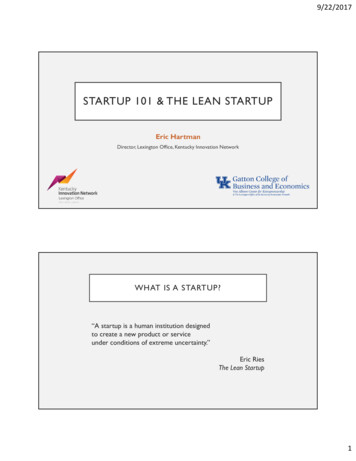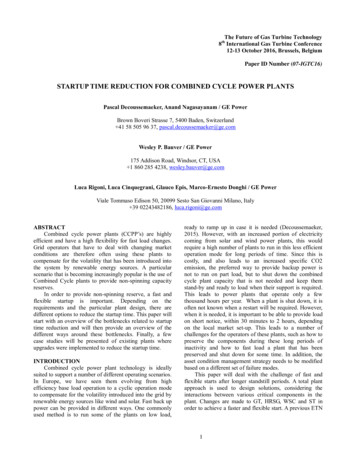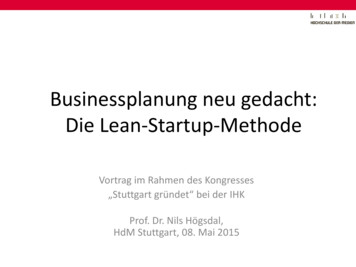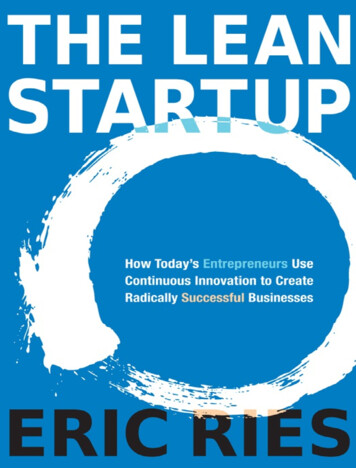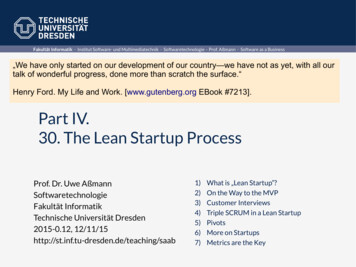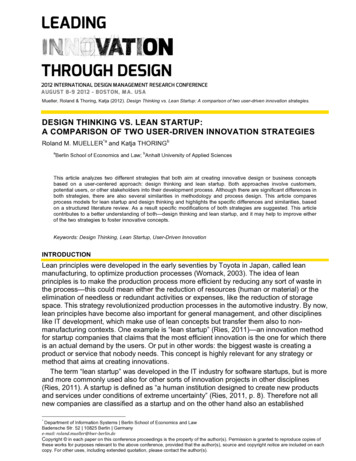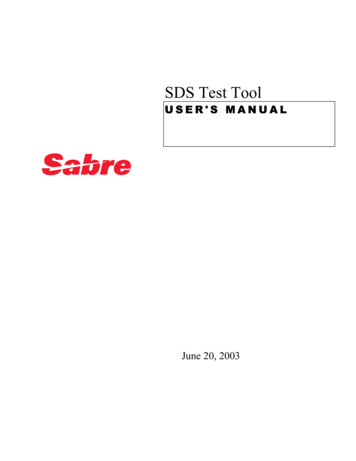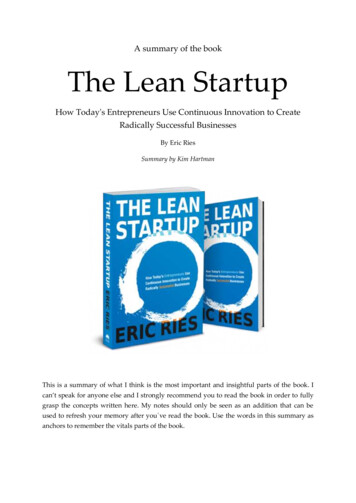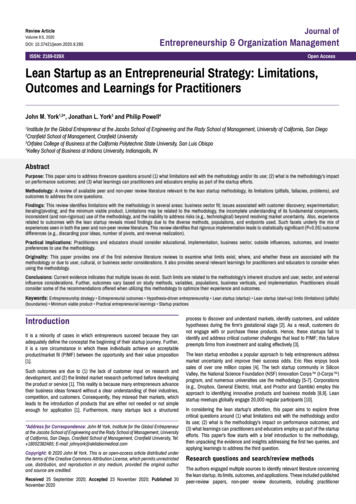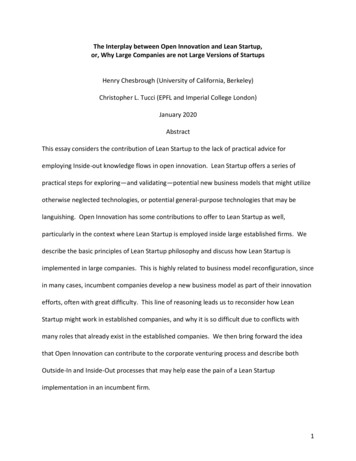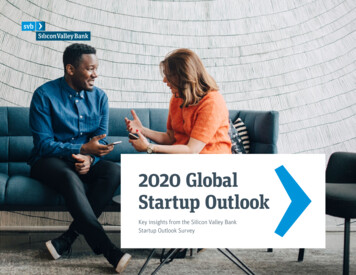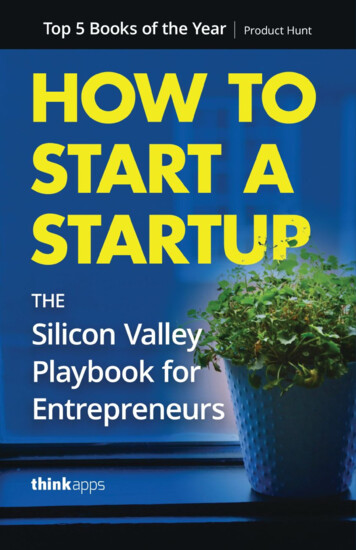
Transcription
This is a sample preview of How to Start aStartup: The Silicon Valley Playbook forEntrepreneurs .To access the full book, please visit theThinkApps book website .
How to Start a StartupThe Silicon Valley Playbook forEntrepreneursThinkAppsPlatoWorks Inc.San Francisco, CA
How to Start a Startup: The Silicon Valley Playbook for EntrepreneursCopyright 2015 by ThinkApps.All Rights Reserved, except where otherwise noted.Published by PlatoWorks Inc.First Edition, PaperbackISBN 978-0-9972685-1-5
ContentsPrefaceixIntroduction1PART I. EARLY DAYS1.Read This Before You Even Think AboutStarting a Startup9Featuring: Sam Altman and Dustin Moskovitz2.Never Stop Learning15Featuring: Paul Graham3.Legal and Accounting 10121Featuring: Carolynn Levy and Kirsty NathooPART II. LEADERSHIP4.How to Be a Great Founder35Featuring: Reid Hoffman5.Operational Insight: How to Build a CompanyThat Can Manage ItselfFeaturing: Keith Rabois43
6.Management Advice: The Art of BalancingCompeting Interests53Featuring: Ben HorowitzPART III. BUILDING PRODUCTS7.How to Build Products Users Love67Featuring: Kevin Hale8.Competition Is for Losers75Featuring: Peter Thiel9.Designing Hardware for the Internet of Things85Featuring: Hosain Rahman10.Why You Should Build for the Enterprise93Featuring: Aaron LeviePART IV. REACHING YOUR AUDIENCE11.How to Run a Successful User Interview103Featuring: Emmett Shear12.Getting Press the Right Way113Featuring: Justin Kan13.How to Land Early Customers119Featuring: Tyler BosmenyPART V. FUNDRAISING14.How to Raise MoneyFeaturing: Marc Andreessen, Ron Conway, andParker Conrad125
15.Perfecting Your PitchFeaturing: Michael Seibel, Dalton Caldwell, andQasar Younis131PART VI. HIRING16.How to Hire the Best Team141Featuring: Sam Altman17.Creating Company Culture151Featuring: Alfred Lin18.Advice on Hiring and Culture from theFounders of Pinterest and Stripe159Featuring: Ben Silbermann, John Collison, andPatrick CollisonPART VII. SCALING19.Doing Things That Don’t Scale173Featuring: Stanley Tang and Walker Williams20.3 Essentials for Scaling181Featuring: Adora Cheung21.Lessons from Facebook’s VP of Growth187Featuring: Alex SchultzPART VIII. PARTING WORDS22.What Comes After Finding Product-Market Fit199Featuring: Sam AltmanAfterword211
PrefaceHow to Start a Startup is based on a Stanford University courseof the same name taught by Y Combinator, the prestigiousstartup accelerator behind billion-dollar companies likeDropbox and Airbnb.Thisreferencebook waswrittenandpublishedindependently by ThinkApps, a product development servicepowering top Silicon Valley startups and innovativeenterprise companies.ThinkApps’ mission is to build great products. From veloped apps used by millions of users and, in the process,become deeply immersed in the world of startups.When Y Combinator began its “How to Start a Startup”course, we quickly recognized that its lectures capturedmany of the key learnings from which early-stage founderswould bene\t.ix
PrefaceUsing the course material as a starting point, we decided towrite the ultimate Silicon Valley playbook for entrepreneurs— a detailed guide to everything you’ll need to know in theearliest stages of your company.In the chapters that follow, you’ll learn from 25 insiders like: Reid Hoffman, LinkedIn co-founder Dustin Moskovitz, Facebook co-founder Marc Andreessen and Ben Horowitz, co-founders ofNetscape and Andreessen Horowitz venture capital \rm Peter Thiel, co-founder of PayPal and Founders Fund,early Facebook investor Ben Silbermann, Pinterest co-founder and CEOThese experts will reveal the secrets to raising money,building products users love, hiring a great team, gettingpress coverage, attracting customers, scaling up, and more.Our hope is that How to Start a Startup will take the wisdomand energy of Silicon Valley and spread it worldwide,motivating and educating aspiring entrepreneurs and earlystage startup founders around the globe.ACKNOWLEDGEMENTSIn addition to acknowledging Stanford University and YCombinator (especially president Sam Altman), we’d like torecognize the tech founders, executives, and investors whox
Prefaceserved as speakers for the “How to Start a Startup” course.Their lessons are highlighted throughout this book.Ourthanksalsogoto TarunAgarwal,KatelanCunningham and Becky Cruze for their substantial roles inbringing this book to life, as well as to Hrvoje Bielen forcover design.xi
Introduction“Starting a successfsuccessfulul startup is similar to having kids; it’s like abutton you prpressess and it changchangeses your liflifee irrirrevocablevocably.”y.” Paul GrGrahamahamAs Paul Graham, co-founder of the prestigious YCombinator startup accelerator, noted in a lecture at StanfordUniversity, starting a successful startup — like having kids— is life-changing.It’s similar to raising children in another way, as well: it’s oneof the most challenging yet rewarding things you can do.STARTUPS ARE EATING THE WORLDModern life is shaped by products and services conceived anddeveloped by creative people. Where we live, what food andentertainment we consume, and how we learn, work, andtravel are all constantly evolving.In 2011, legendary entrepreneur and investor MarcAndreessen claimed, “Software is eating the world.” Today,1
Introductionit might be more accurate to say that startups are eating theworld.But before jumping into an in-depth discussion of startups,let’s make sure we’re all working o[ the same de\nition ofthese businesses.As de\ned by Graham, “A startup is a company designed togrow fast.”Disruption and innovation are the driving forces behind thesehigh-growth companies. Naturally, disrupting the status quoand inventing new products and services is hard work withunpredictable outcomes.Yet, despite the challenges, there are always entrepreneurswilling to cast o[ the safe and familiar in order to explore thenext frontier.A large portion of these entrepreneurs seem to be living andworking in Silicon Valley. Why is that? And is it necessaryfor success?SILICON VALLEY IS STARTUP CENTRALClusters are an important organizing principle. Within theUnited States, for example, there are clusters of \nancial \rms(Wall Street), automobile makers (Detroit), institutions ofhighereducation(Boston),companies (Los Angeles).2andentertainment
IntroductionWith proximity comes dissemination of knowledge, crosspollination of ideas, and economic e ciency of activities.As one of the oldest and most successful technology startupclusters, Silicon Valley continues to o[er advantages for newentrepreneurs. One can learn from experienced founders, hiretalent, \nd partners, raise funding, etc. more easily than inmost places.However, modern technology companies are unique in thatgeographic location fundamentally plays a limited role in the\nal product. Software can increasingly be built anywhereand used anywhere regardless of where it is built.EXPORTING SILICON VALLEY EXPERTISE AROUNDTHE GLOBESuccessful startups are built on new ideas. However, thatdoesn’t mean they have nothing to learn from those that camebefore. In fact, quite the opposite.Although the path traveled by each startup will have its ownparticular twists and turns, there are many commonchallenges founders will face along the way: How can you test the merits of your business idea? How do you build the right team to help you? How do you raise funding to fuel the engine? What legal and \nancial basics do you need to know?3
Introduction How do you get the attention of the market and learnabout your (potential) users? What’s the best way to build and ship products? How do you transition from the early stages to realizing afull business?While each situation is distinct, knowing what has succeededor failed in similar contexts in the past provides a greatstarting point.Fortunately, Silicon Valley has a strong culture of openness,with founders and investors willing to pull back the curtainand share what they’ve learned along the way. And theselessons will most likely be relevant regardless of where yourstartup is based.OUR GOALThis book brings together advice from more than 25experienced entrepreneurs, technologists, investors, andbusiness executives behind successful companies of the pastand present like Netscape, PayPal, Facebook, LinkedIn, andPinterest.Our objective is to share insight across the entire startupjourney, from the earliest days when an idea is germinatingall the way to when you ship products and begin scaling yourbusiness.4
IntroductionYou can read this book over a weekend and get the insidescoop on the hard lessons these smart people have learnedover the course of decades.Ultimately there is no exact recipe for success, but learningfrom the experience of others can help you to be betterprepared as you set o[ on your own journey to explore thenext frontier.5
PART IEarly DaysWhether you’re working from your living room, a co[eeshop, or a coworking space, it’s never too early to lay a solidfoundation for your business.
1Read This Before You EvenThink About Starting aStartupFeaturing: Sam Altman and Dustin MoskovitzBecBecomingoming an entrentreprepreneureneur is not all luck and a few late nights. Nomatter how fun big startup oHces lolook,ok, getting thertheree takes a lot ofwork.That was the theme when Sam Altman (president of YCombinator) and Dustin Moskovitz (co-founder of Facebookand Asana) gave a joint lecture at Stanford University.9
ThinkAppsTHE TRUTH ABOUT STARTUPSTheir talk kicked o[ with the words of Phil Libin, CEO ofEvernote:“P“Peopleeople have this vision of being the CEO of a company they startedand being on top of the pyrpyramid.amid. Some people araree motivmotivatedated by that,but that’s not at all what it’s like. What it’s realleallyy like: Everyoneelse is your boss – all of your employees, customers, partners, users,[and the] media araree your boss. I’ve never had mormoree bosses andneeded to accaccountount for mormoree people. If you want to exercise power andauthority over people, join the military or go into politics. Don’t bean entrentreprepreneur.”eneur.”In other words, only start a startup if you feel compelled by aproblem and think that building a company will solve it.Altman said that the passion comes \rst and the startupsecond. Along with the passion, you need the aptitude.Moskovitz broke it down like this: Passion means you need to do it. You’ll need thatpassion to endure The Struggle and to recruit e[ectively. Aptitude means the world needs you to do it. Theworld needs you somewhere, \nd where.ROADMAP TO STARTUP SUCCESSGot the passion and the aptitude? Then starting a startup maybe your true calling. But, you’ll need some guidelines to helpyou ]ourish.10
How to Start a StartupAccording to Altman, the \rst two things you need tomaximize startup success are:1. A great idea2. A great productFINDING YOUR GREAT IDEAAltman said that no matter how well you execute it, a badidea will get you nowhere.This is where a lot of founders drop the ball. There’s thispervasive rhetoric in startup culture that it’s feasible to startyour business with a bad idea. That maybe, if you pivotenough, it’ll all work out in the end. But Altman said this isnot a good move because it doesn’t actually work out.If your startup succeeds, chances are you’ll be working onit for 10 years — if it fails, the timeline is more like \veyears. If you’re going to be in it to see your idea through tosuccess, it’s essential that you seriously mull it over and naildown your mission.The best companies are mission-oriented. With a solidmission in place, you’ll get a more motivated team that willrally around you.HOW DO YOU KNOW IF YOU HAVE A GREAT IDEA? You can answer the question: Why now? Why is thisthe perfect time for this particular idea instead of two yearsago or two years from now?11
ThinkApps You’re building something you yourself need. (If not,get really close to your customers.)BUILDING A GREAT PRODUCTAfter the idea stage, the next step is building an amazingproduct.Altman said that looking at market growth is key. You needa market that’s going to evolve in 10 years. And it’s better tohave a small but rapidly growing market, instead of a largebut slowly growing market.Build something that a small number of users love, not justlike. If customers are pretty desperate for a solution, thenthey’ll settle on the \rst product even if it’s subpar. If yourcustomers love your product, your startup will grow by wordof mouth.When it comes to getting feedback, handpick your earlyusers. Pinterest co-founder Ben Silbermann (who is featuredin a later chapter) actually went up to people in co[ee shopsand asked them to test the then-unknown social network.He would even go into the Apple Store and put it in thebrowsers on all the laptops so it was the \rst thing customerssaw. Whatever works!THE PRODUCT BUILDING CYCLE1. Show it to users.2. Get user feedback. What do they like? What features12
How to Start a Startupwould they pay for? Would they recommend it? Wouldthey be bummed if your product went away?3. Make a product decision based on your findings.4. Repeat.BECOMING A STARTUP FOUNDER IS NOT FOREVERYONEIf, after reading this, you realize that the startup life isn’t foryou, that’s okay. You’ve been spared a ton of stress and soulcrushing responsibility. It’s not the end of the road for you.It may not seem like it because of the way the mediaromanticizes entrepreneurship, but there are other things youcan do with your life if you want to maximize your earningpotential, have a ]exible schedule, and be successful.When you consider that the 100th engineer at Facebookmade far more money than 99% of Silicon Valleyentrepreneurs, not being the person in charge starts to lookpretty good.Moskovitz recommended proposing a late-stage feature to anestablished company if you want to be innovative, use yourtalent, and receive a big \nancial return. All of that comeswithout the stress and responsibility of being the founderbecause you’re not starting from scratch.Indeed, innovating for a later-stage company means you getaccess to a massive user base, existing infrastructure, and anestablished team.13
ThinkAppsNeed more motivation? Google’s 1,500th employee createdGoogle Maps. Facebook’s 250th hire led the project for the“Like” button.THE TAKE-AWAYBeing an entrepreneur is not the only path to innovativesuccess. But if it is the path for you, read on for insightsfrom some of the top founders, executives, and investorsin Silicon Valley.14
This is a sample preview of How to Start aStartup: The Silicon Valley Playbook forEntrepreneurs .To access the full book, please visit theThinkApps book website .
Startup Featuring:SamAltmanandDustinMoskovitz Becoming an entrepreneur is not all luck and a few late nights. No matter how fun big startup oHces look, getting there takes a lot of work. That was the theme when Sam Altman (president of Y Combinator) and Dustin Moskovitz (co-founder of
